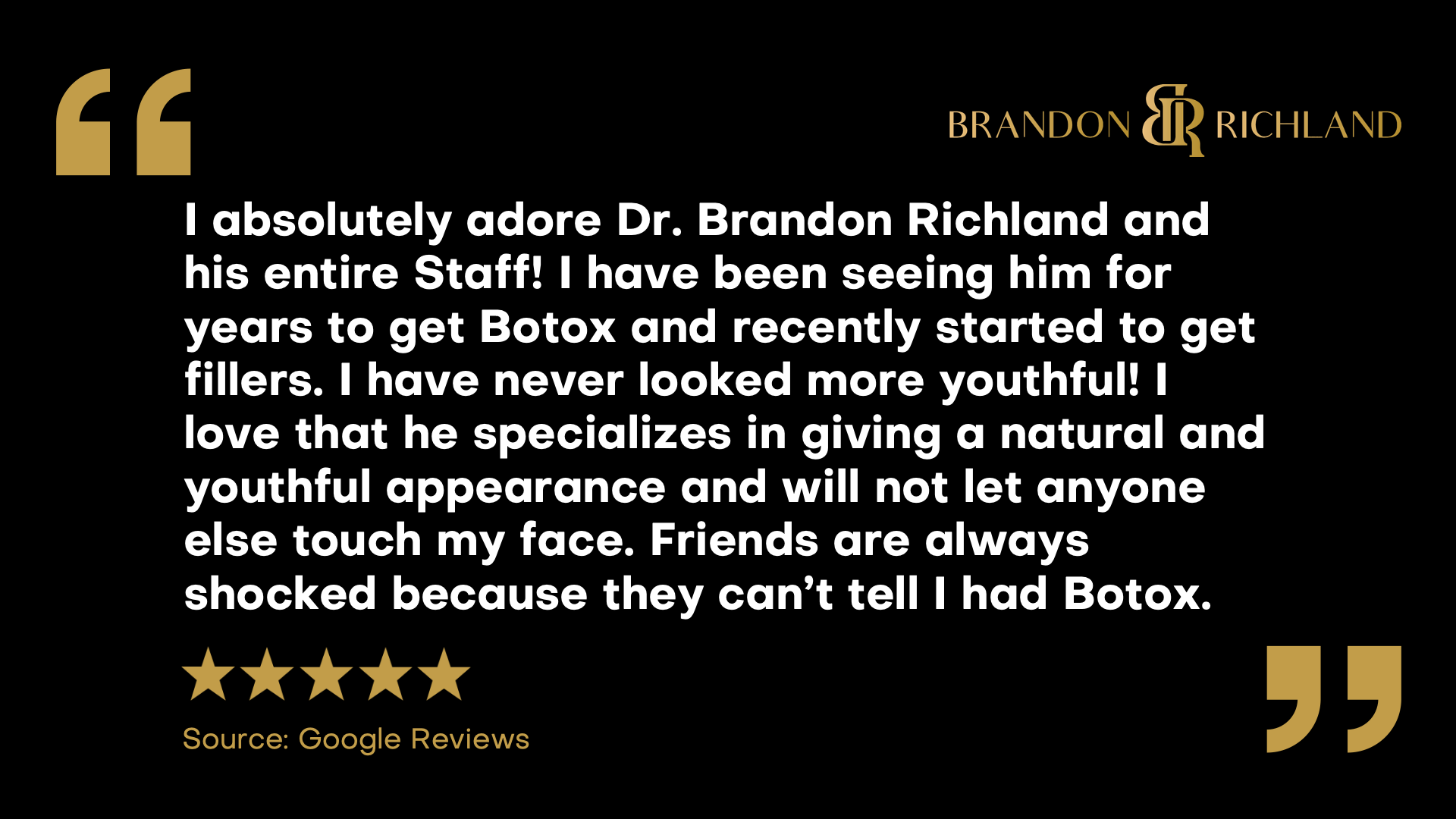Published by Dr. Brandon Richland, MD

“I absolutely adore Dr. Brandon Richland and his entire Staff! I have been seeing him for years to get Botox and recently started to get fillers. I have never looked more youthful! I love that he specializes in giving a natural and youthful appearance and will not let anyone else touch my face. Friends are always shocked because they can’t tell I had Botox.”
Read the full Google Review here.
Understanding Botox and Dermal Fillers
Botox and dermal fillers are cosmetic treatments aimed at rejuvenating the skin by reducing the appearance of wrinkles and adding volume to facial features.
Types of Fillers and Neuromodulators
Hyaluronic acid (HA) based fillers such as Juvederm and Restylane are popular for adding volume and fullness to the lips, cheeks, and smoothing nasolabial folds. Calcium hydroxylapatite, found in Radiesse, and poly-L-lactic acid, the main ingredient in Sculptra, are biocompatible and used for deeper lines and volume restoration. Neuromodulators like Botox, Dysport, Xeomin, and Jeuveau utilize botulinum toxin to relax facial muscles and address dynamic wrinkles.
- Common Fillers:
- Hyaluronic Acid: Juvederm, Restylane
- Calcium Hydroxylapatite: Radiesse
- Poly-L-Lactic Acid: Sculptra
- Neuromodulators:
- Botulinum Toxin Type A: Botox, Dysport, Xeomin, Jeuveau
Treatment Areas and Aesthetic Goals
Dermal fillers are ideal for restoring volume in areas such as the cheeks, lips, chin, and hands, creating a smoother, fuller appearance. Botox and other neuromodulators specifically target the forehead, crow’s feet, and frown lines to reduce muscle activity and smooth out dynamic wrinkles that occur with facial expressions.
Procedure and Aftercare
The injection process is brief, usually taking less than an hour. Patients may experience temporary redness, swelling, or bruising at the injection site. Post-treatment care includes avoiding strenuous exercise and heat exposure for the first 24 hours to minimize swelling.
Risks and Side Effects
- Common Side Effects:
- Temporary: Bruising, swelling, redness, pain
- Rare: Infection, allergic reactions, lumps
- Severe Risks:
- Drooping eyelid, muscle weakness, blood vessel injury, possible blindness
Regulatory and Medical Considerations
All products like Botox and injectable fillers should be FDA-approved and administered by a board-certified dermatologist or plastic surgeon. Consult with a medical professional to understand the costs, which are not typically covered by insurance, as well as the safety and potential benefits of each treatment.
Longevity of Results
The effects of neuromodulators generally last between 3 to 4 months, while dermal filler results can last anywhere from 6 months to over a year, depending on the product used. For instance, hyaluronic acid-based fillers may last up to 18 months, while polylactic acid fillers like Sculptra are known for their long-lasting results. Regular maintenance is required to preserve the desired outcome.
Selecting the Right Treatment
When deciding between botox and fillers, it’s crucial to understand the specific benefits and considerations of each. Exploring options with medical professionals, understanding cost, and recognizing the recovery process are vital steps to making an informed decision.
Evaluating Injection Options
Botox injections, which are a form of neuromodulator, work by temporarily paralyzing the muscle movement that leads to dynamic wrinkles associated with facial expressions. These are particularly effective for areas like the forehead and around the eyes. Fillers, which often include hyaluronic acid, restore volume and fullness, addressing lines, wrinkles, and areas of the face that have lost elasticity and may appear sagging.
- Botox: Best for dynamic wrinkles caused by muscle movement
- Fillers: Ideal for static wrinkles, restoring volume, and correcting sagging
Assessment by Medical Professionals
It is imperative to consult with a board-certified dermatologist or plastic surgeon to assess facial concerns and recommend the most suitable treatment. During a consultation, the professional will examine the patient’s skin condition, discuss desired results, and consider the patient’s medical history to ensure safety.
- Consultation Focus:
- Skin assessment
- Discussion of desired outcomes
- Medical history review for contraindications
Cost Considerations
The cost of Botox and fillers can vary widely depending on geographic location, practitioner’s expertise, and the amount of product used. Botox is generally priced per unit, while fillers are priced per syringe. Cosmetic procedures are seldom covered by insurance, so patients should be prepared for out-of-pocket expenses.
- Average Cost Estimates:
- Botox: $10-$20 per unit
- Fillers: $500-$1,000 per syringe
Understanding Recovery and Maintenance
Post-treatment, patients may experience temporary side effects like bruising, swelling, or rash. It’s less common, but possible, to have more serious complications like scarring. Patients should follow their practitioner’s guidelines on recovery to mitigate these risks. Both Botox and fillers require maintenance sessions to uphold results.
- Post-Treatment Expectations:
- Botox: 3-4 months of effect, with follow-up treatments for maintenance
- Fillers: Last 6 to 18 months, varies by filler type and area treated
Case Studies and Patient Experiences
In the world of non-surgical facial rejuvenation, Botulinum toxin A (BoNT-A) injections stand out for their ability to soften lines and wrinkles associated with aging. Many patients who seek a more youthful appearance turn to plastic surgeons and dermatologists to receive these neurotoxin injections.
A case study reported a unique lifting effect on the jawline when muscles in the lower face were relaxed with BoNT-A, enhancing both the contour and the patient’s resting facial expression. This underscores the potential of BoNT-A in lower face rejuvenation, although it is often less recognized for this area.
Patient Outcomes
Patients often report satisfaction with the reduction in appearance of aging signs through judicious use of Botox injections. The desired results typically include diminishing frown lines, forehead creases, and crow’s feet by restricting muscle movement near these wrinkles.
- Positive Effects:
- Improved Appearance: Smoothed wrinkles and a rested look.
- Youthful Feel: Less sagging and more defined facial features.
- Adverse Reactions:
- Minor Reactions: Some patients experience temporary bruising, swelling, or tiny bumps at the injectionsite.
- Rare Complications: Though uncommon, cases are reported with more serious effects, necessitating careful patient consultation and selection.
Expert opinions stress the importance of a thorough pre-treatment consultation with a qualified professional to discuss potential risks and establish safety measures. Prospective patients are advised to fully understand both the procedure and any contraindications.
Expert Involvement
Plastic surgeons and dermatologists with expertise in Botox injections emphasize the necessity for personalized treatment plans. They review the patient’s medical history and tailor the injections to the individual’s facial anatomy, which plays a crucial role in achieving optimal results and ensuring safety.
Schedule Your First-Class Cosmetic Consultation with Dr. Brandon Richland, MD
Contact Dr. Richland today by visiting RichlandMD.com, scheduling a cosmetic consultation, or by calling 714-844-0398 or 949-997-2958 directly.

Cover Image Illustration by: Dr. Brandon Richland, MD










